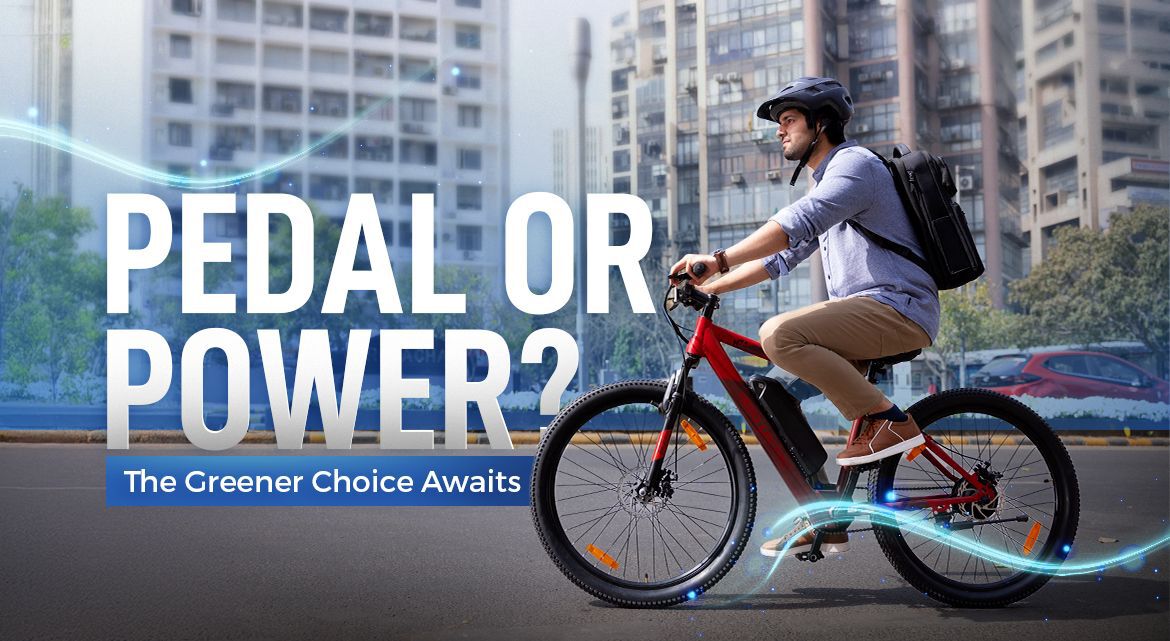E-Bikes vs. Traditional Bicycles and Cars: Which is More Sustainable?
Lectro E-BikesHero Lectro | 24 March, 2025

Sustainability is a growing concern as cities become more congested and pollution levels rise. People are now looking for eco-friendly ways to travel, and electric bikes (e-bikes) have emerged as a popular alternative.
But how do electric cycles compare to traditional bicycles and cars in terms of environmental impact? Let’s break it down.
1. Energy Consumption: How Much Power Do They Use?
One of the key factors in sustainability is energy use.
a. Cars rely on fossil fuels or electricity, consuming significant energy per mile. Even electric cars require large batteries, which take a toll on the environment.
b. E-bikes use rechargeable batteries but consume much less energy compared to cars. A fully charged e-bike battery can last up to 50-100 km, using only a fraction of the electricity a car needs.
c. Traditional bicycles require zero electricity, making them the most energy-efficient option.
While traditional bicycles win in energy efficiency, e-bikes still consume far less energy than cars, making them a sustainable choice for urban commuting.
2. Carbon Footprint: Emissions and Pollution
Reducing carbon emissions is essential in fighting climate change.
a. Cars are the biggest polluters among the three. A petrol or diesel car emits an average of 120-150 grams of CO₂ per km. Even electric cars contribute to emissions indirectly through electricity generation.
b. E-bikes produce minimal carbon emissions. They emit around 2-5 grams of CO₂ per km, mainly from electricity production.
c. Traditional bicycles have no direct emissions, making them the most eco-friendly option.
Switching from a car to an e-bike can significantly reduce your carbon footprint while providing a convenient and efficient way to travel.
3. Battery and Manufacturing Impact
A common concern with e-bikes is battery production and disposal.
a. E-bikes use lithium-ion batteries, which require mining of materials like lithium and cobalt. However, modern batteries are becoming more efficient and recyclable. Many manufacturers are also working on sustainable battery solutions.
b. Cars use much larger batteries (if electric) or rely on fossil fuels, making them less sustainable.
c. Traditional bicycles don’t require batteries, making them the most sustainable in this aspect.
Although e-bikes have a small environmental cost in production, the long-term benefits of electric cycles outweigh the impact when compared to cars.
4. Space and Infrastructure: How Do They Fit in Cities?
Urban congestion is a major issue, and the type of vehicle you choose affects road space and infrastructure.
a. Cars take up a lot of space, contribute to traffic congestion, and require large parking areas.
b. E-bikes are compact, require less parking space, and can often use bicycle lanes.
c. Traditional bicycles are similar to e-bikes in space efficiency, making them ideal for city commuting.
By choosing e-bikes over cars, cities can become more livable, with fewer traffic jams and better air quality.
5. Cost: Which Is More Affordable?
Sustainability isn’t just about the environment, it’s also about long-term affordability.
a. Cars are the most expensive to buy, maintain, and fuel. Even electric cars have high initial costs and require charging stations.
b. E-bikes cost more than traditional bicycles but save money in the long run. They have lower maintenance costs compared to cars and no fuel expenses.
c. Traditional bicycles are the most affordable, with minimal maintenance costs.
E-bikes offer an excellent balance between affordability and convenience, making them a practical choice for modern commuters. With a wide range of options available, the electric bike price varies based on features, battery capacity, and design, allowing riders to find one that fits their budget and needs.
6. Health Benefits: Do E-Bikes Keep You Fit?
Physical activity is an important factor when choosing a mode of transport.
a. Traditional bicycles provide the most exercise since they require full pedaling effort.
b. E-bikes also offer health benefits, as most riders still pedal while using pedal-assist mode. Studies show that e-bike users ride more frequently and for longer distances than regular cyclists.
c. Cars provide no exercise, leading to a sedentary lifestyle.
E-bikes make cycling more accessible to people of all ages and fitness levels, promoting a healthier lifestyle.
Must Read: Does Cycling Increase Height?
7. Longevity and Waste: How Long Do They Last?
The longer a product lasts, the more sustainable it becomes.
a. Traditional bicycles can last decades with proper maintenance.
b. E-bikes also have long lifespans, with batteries typically lasting 3-5 years. Many parts are repairable, reducing waste.
c. Cars have shorter lifespans compared to bicycles and generate massive waste, from tires to engine parts.
Proper maintenance and battery recycling can further enhance the sustainability of e-bikes.
Which One Should You Choose?
When comparing e-bikes, traditional bicycles, and cars, it is clear that e-bikes offer the best balance between sustainability, convenience, and efficiency. Traditional bicycles remain the most eco-friendly option, but they may not be practical for long commutes or hilly terrains. Cars, on the other hand, have the highest environmental impact, making them the least sustainable choice.
E-bikes, like those from Hero Lectro significantly reduce carbon emissions, save space, and provide an affordable, energy-efficient solution for modern commuting. Whether you're looking to reduce your carbon footprint, save money, or enjoy an easier ride, an e-bike is the ideal choice for a cleaner, greener future.


